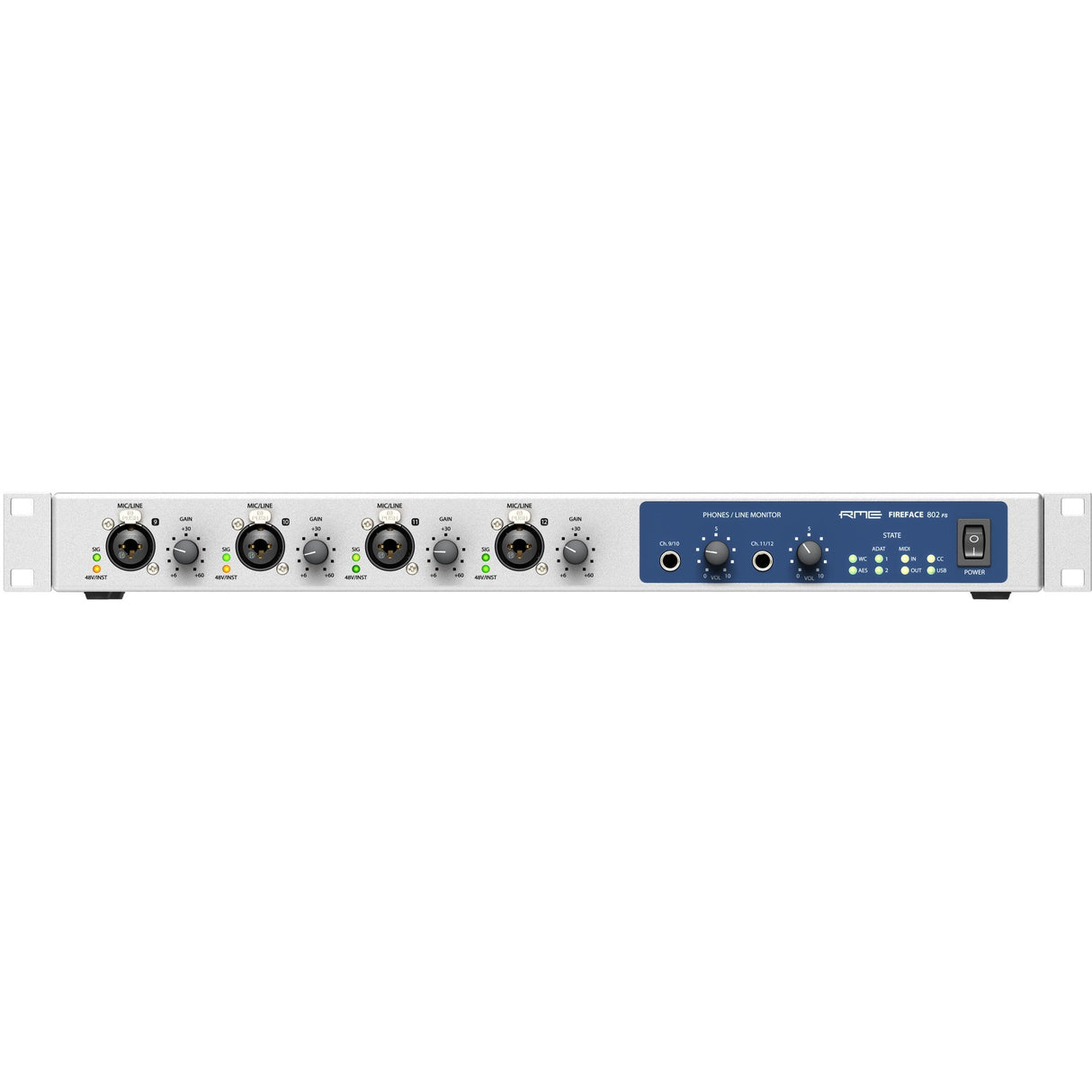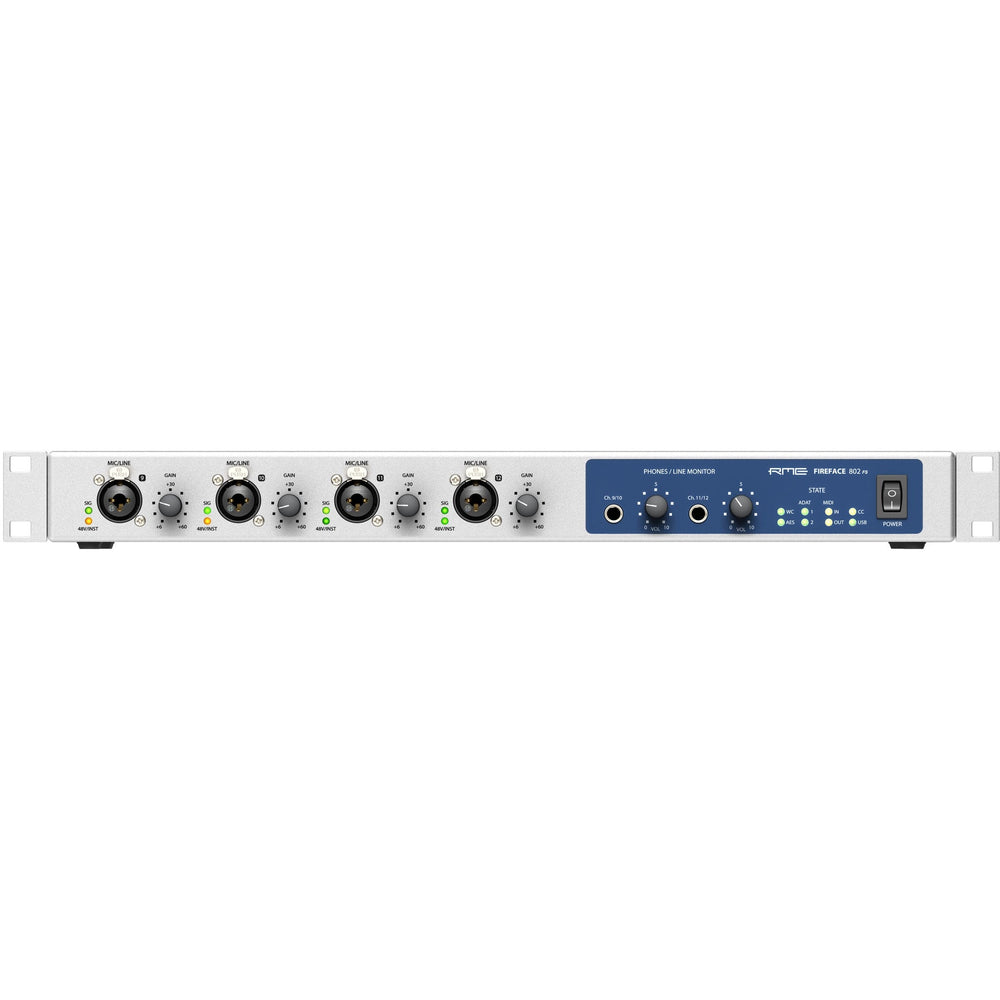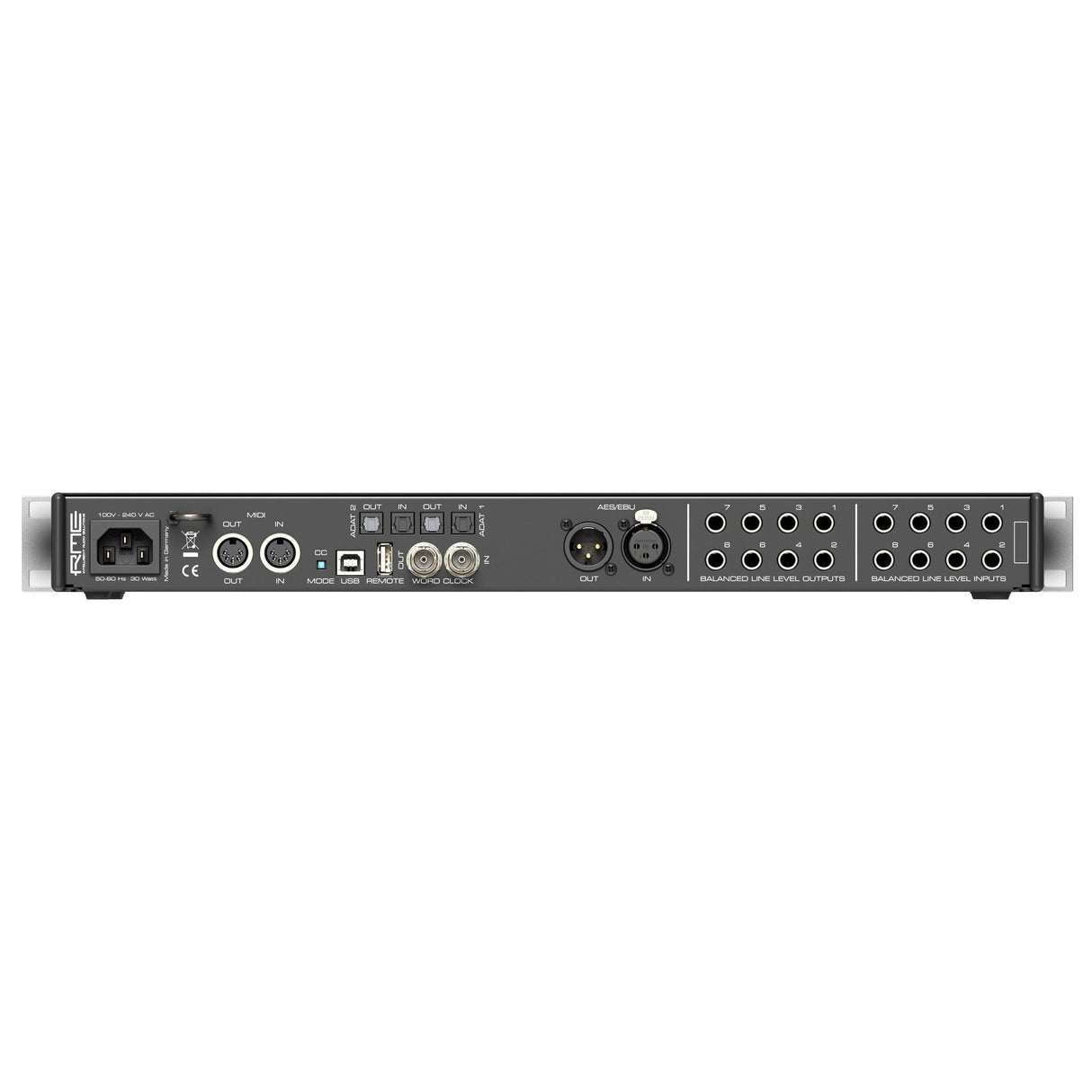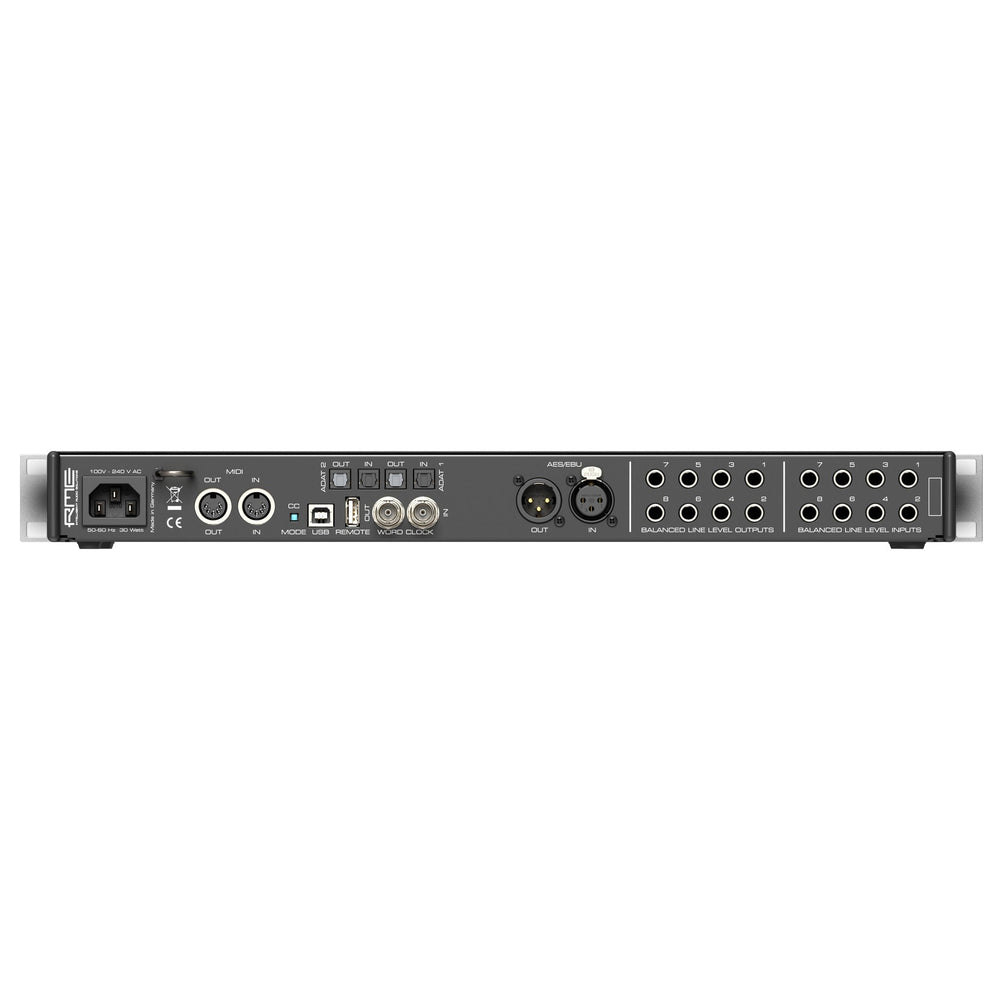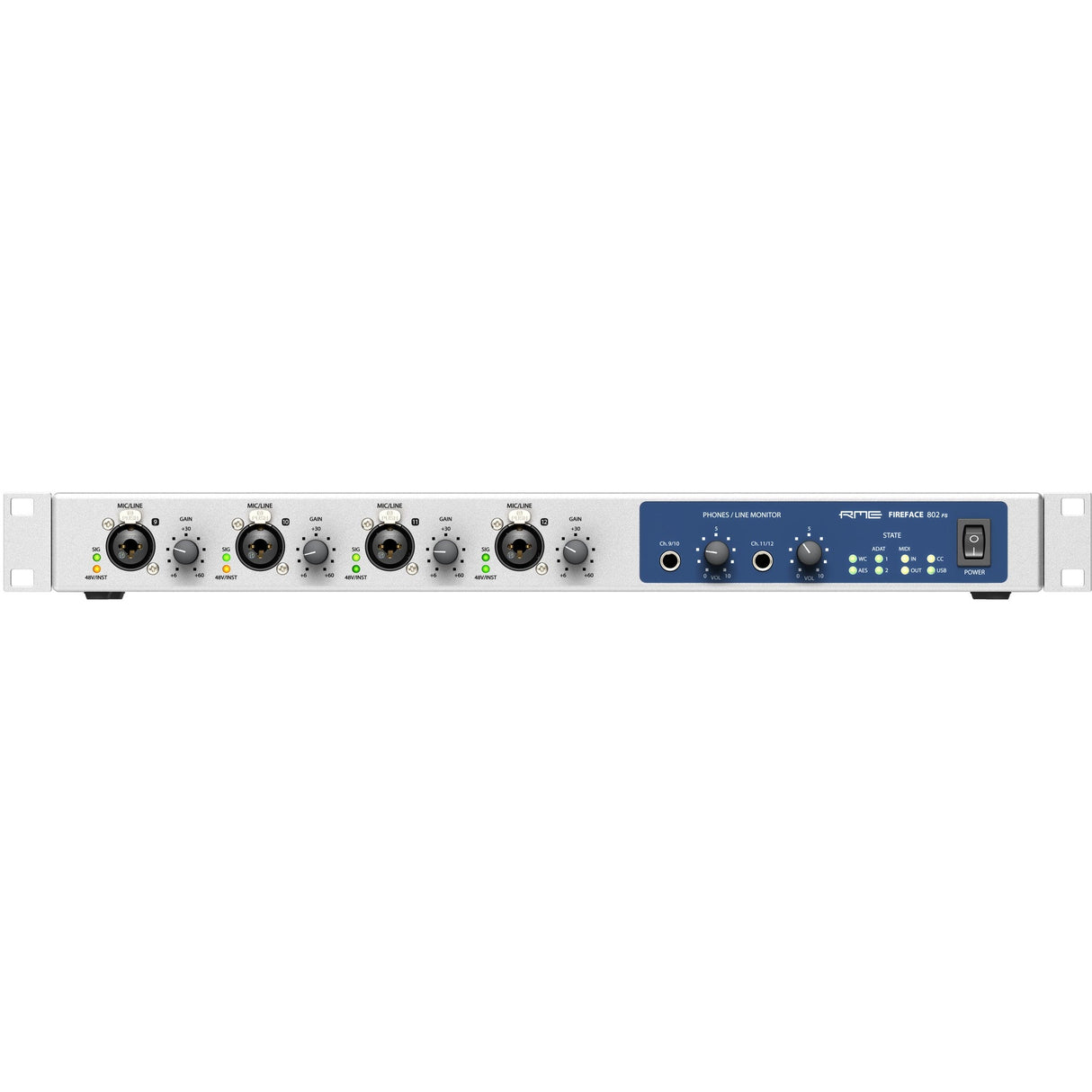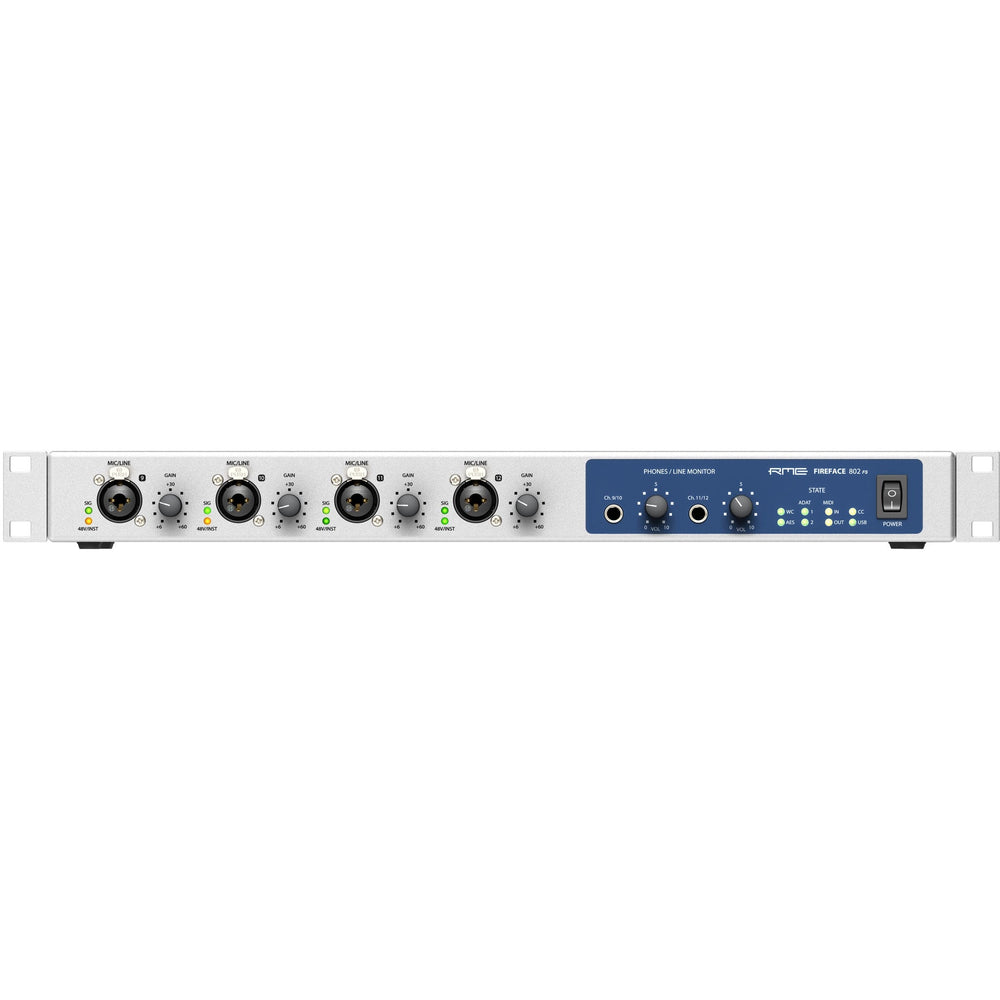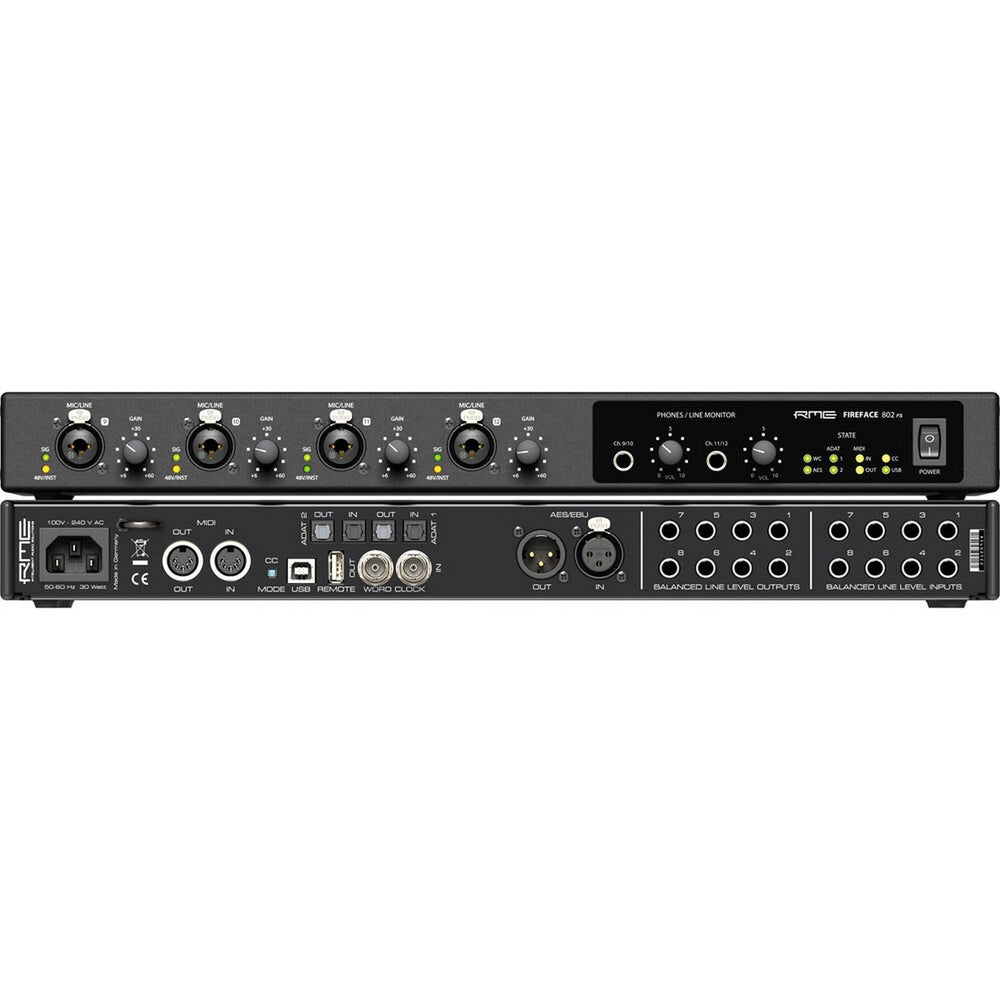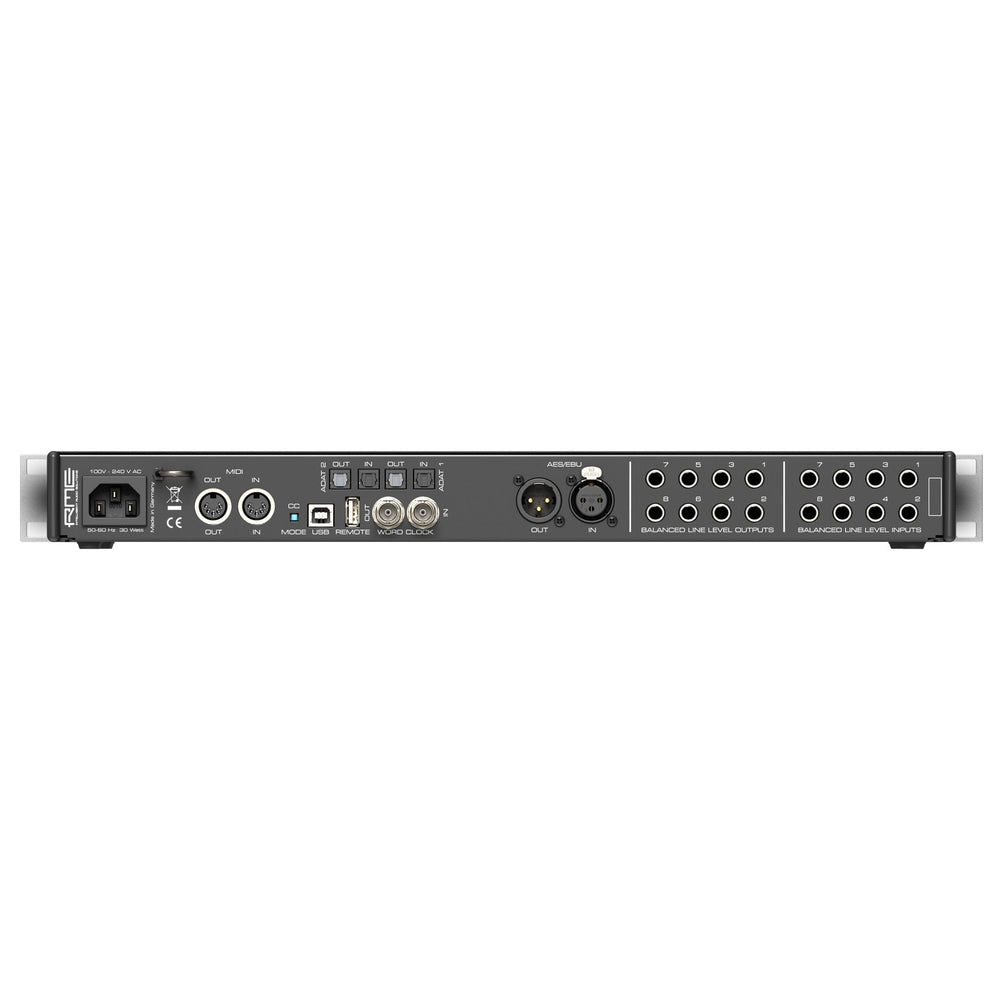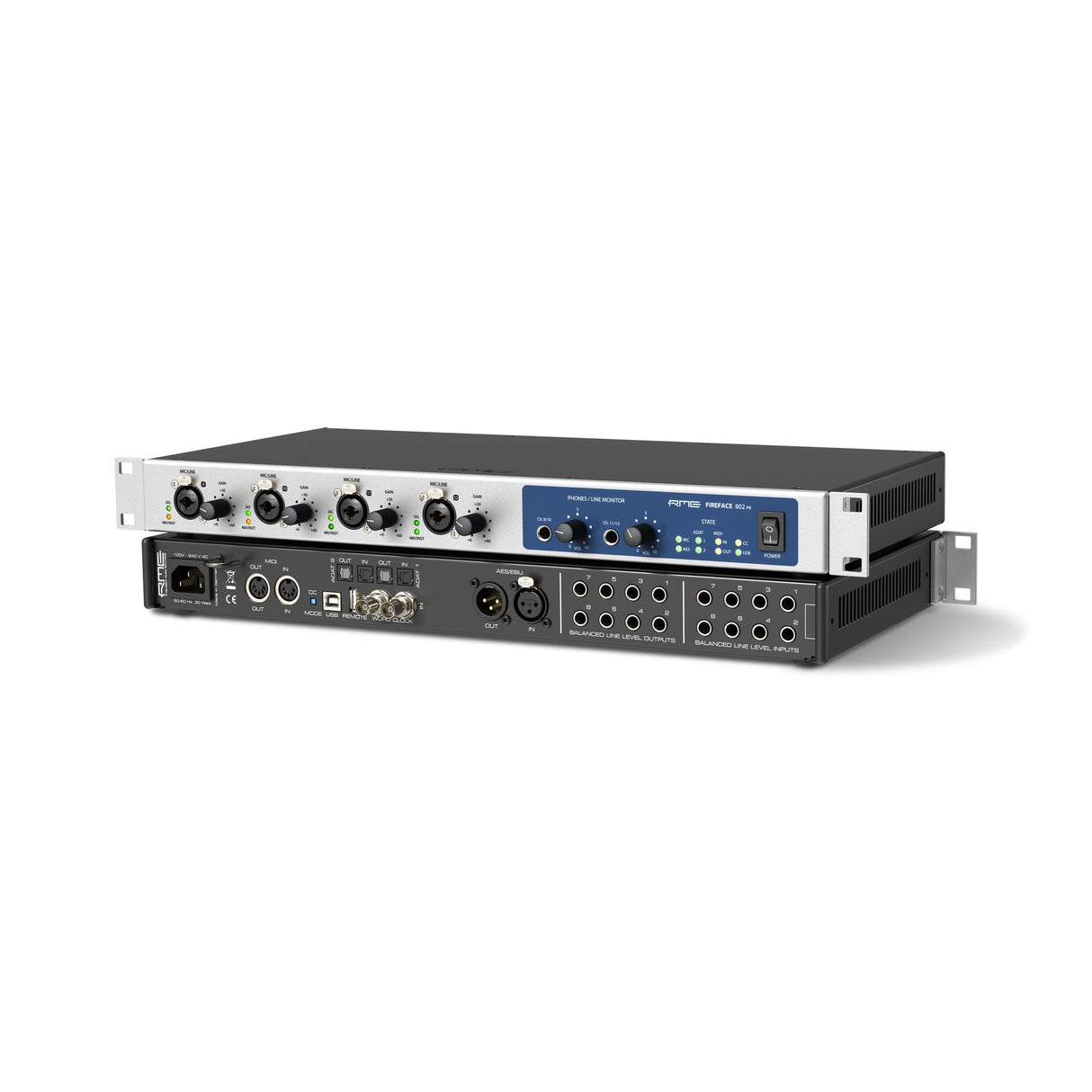Free Shipping
More finance options:
Estimated Shipping Widget will be displayed here!
Condition: New
Description
RME Fireface 802 FS 60-Channel 192 kHz High-End USB Audio Interface
The Fireface 802 FS is a highly integrated pro audio solution for live and studio use, all within a 19” enclosure. An interface designed for users who don’t want to make compromises in sound, stability and ultra-low latency operation, and who long for an unrivaled professional feature set. Once again a milestone interface from RME, including the best of the best and even a bit more. 60 channels of audio, high-end microphone preamps, reference class converters, a complete effects section and operation at up to 192 kHz are the base for many more features.
Enhance Your Recording Setup - Discover Unmatched Flexibility
Ultra-low latency operation with RME USB 2 technology, combined with the legendary RME driver stability and maintenance. SteadyClock FS jitter suppression, individually switchable reference levels for all inputs and outputs, full stand-alone functionality and identical operation on Windows PC and Mac completes the package.
The Fireface 802 FS is based on a newly developed analog and digital board. While the analog board offers, for example, DC-coupled analog outputs as well as new AD and DA converters, the digital board also enables interesting new features thanks to updated high-tech components.
The front panel of the Fireface 802 FS provides four high-performance XLR/TRS combo inputs for microphone, instrument and line signals and two stereo headphone jacks with +17 dBu output level, to provide high volumes even with hi-impedance headphones.
The rear panel reveals the full connectivity of the Fireface 802 FS. Besides MIDI and Word Clock I/O, the two optical ADAT I/Os, an AES/EBU I/O, and eight balanced analog inputs and outputs with line level are available. With the new Multi-Mode, the two ADAT I/Os can be used as separate optical SPDIF inputs and outputs in addition to the AES I/O. Users will also find a USB A port for connecting directly the optional available ARC USB.
Powerful Applications for Mixing, Monitoring and Measurement included
The Fireface 802 FS comes with the TotalMix FX DSP mixer offering comprehensive routing and monitoring options, as well as the DigiCheck Analyzer allowing to measure and analyze the digital data feed in both directions with maximum precision. TotalMix FX can completely replace an external mixer, enabling the creation of multiple latency-free monitor mixes with EQ, Dynamics, Reverb and Delay for any outputs, incl. main monitors and headphone mixes for musicians.
The additional TotalMix Remote is a remote control for TotalMix FX, to control the hardware mixer and effects in RME audio interfaces. TotalMix Remote mirrors the current state of the host system on the iPad and Windows/Mac computers - the entire mixing state, the complete routing, all FX settings, up to the level meters, and everything in real-time. Easily adjust all the mixer and FX settings from a distance, via Ethernet and WiFi.
USB 2 Class Compliant Audio
The Fireface 802 FS operates in two different modes: driver-based USB 2 and Class Compliant. The Class Compliant mode is a standard that is natively supported by operating systems like Windows, Mac OSX and Linux distributions. No proprietary drivers are required, the device will be directly recognized when the CC firmware is loaded. The alternative CC mode can be activated via a recessed pushbutton switch directly at the back of the interface.
The Fireface 802 FS offers full USB 2.0 support in Class Compliant Mode. This makes all channels available in driverless operation for Linux, Mac and iPadOS. An iPad Pro with USB C can manage up to 60 channels for recording and playback in TotalMix FX for iPad and on system level.
DC-Coupled Outputs - CV/Gate Voltage Control
Most audio interfaces are traditionally designed with what is called 'AC-coupled outputs', where capacitors are used to filter out any extreme low frequencies.
Whilst these frequencies are generally considered undesirable for audio - eating into headroom and potentially causing damage to other equipment - one instance where DC-coupling remains desirable is the world of modular synthesizers, where static or slow-moving signals are used for control over various parameters such as pitch note values or LFOs.
All of the Fireface 802 FS line-level outputs are fully DC-coupled, allowing for the sending of control voltages (CV) or Gate information to modular synthesizers (such as the popular Eurorack and Moog/MOTM/Synthesizers formats) and other studio hardware.
ARC USB Remote Control - Plug’n Play Plus
The optional available ARC USB connects to your computer via USB, and talks to TotalMix FX directly. It has 15 freely assignable and illuminated buttons, one encoder wheel, and a TS jack to connect a foot switch.
The ARC USB is a USB 1.1 MIDI remote control for the Fireface 802 FS. Thanks to operating as a UAC 1 class device, it is natively compatible to Windows and Mac OS X. As soon as it is present in the operating system, TotaIMix FX will automatically detect the ARC USB, and communicate with it via simple MIDI remote commands to control the 802 FS.
Connectivity and Features
12 x Analog I/O
4 x XLR/TRS Mic/Inst/Line
2 x Phones Output
1 x AES/EBU I/O
2 x ADAT I/O
2 x SPDIF I/O
1 x Word Clock I/O
1 x MIDI I/O
1 x RME USB 2.0
Class Compliant Mode
TotalMix FX
ARC USB
Including FX
SteadyClock FS
DC-coupled Outputs
Technical Specifications
Analog
AD, Line In 1-8, rear
Input: 6.3 mm TRS, electronically balanced
Signal to Noise ratio (SNR) @ LoGain: 116 dB (AES17), 118 dBA
Signal to Noise ratio (SNR) @ +4 dBu: 115 dB (AES17), 117 dBA
Frequency response @ 44.1 kHz, -0.1 dB: 8.9 Hz - 20.4 kHz
Frequency response @ 96 kHz, -0.5 dB: 4.3 Hz - 45.2 kHz
Frequency response @ 192 kHz, -1 dB: 3 Hz - 89 kHz
Filter: Short Delay Sharp, 5 / 5 / 6 samples delay
THD @ -1 dBFS: < -120 dB, < 0.0001 %
THD+N @ -1 dBFS: < -110 dB, < 0.00032 %
Channel separation: > 110 dB Maximum input level: +19 dBu
Input: 6.3 mm TRS jack, electronically balanced
Input impedance @ 1 kHz: 10 kOhm unbalanced, 10.6 kOhm balanced
Input sensitivity switchable between Lo Gain and +4 dBu
Input level for 0 dBFS @ Lo Gain: +19 dBu
Input level for 0 dBFS @ +4 dBu: +13 dBu
Variable digital gain: 0 to +12 dB
Minimum level for 0 dBFS: +1 dBu, -1.2 dBV
Microphone In 9-12, front
As AD, but:
Input: XLR, electronically balanced
Input impedance: 3.4 kOhm
Signal to Noise ratio (SNR): 113 dB RMS unweighted, 116 dBA
Gain range: 54 dB
Maximum input level, Gain +6 dB: +10 dBu
Maximum input level, Gain +60 dB: -44 dBu
CLIP LED: 0 dBFS
SIG LED: -42 dBFS
Instrument In 9-12, front
As AD, but:
Input: 6.3 mm TS jack, unbalanced
Input impedance: 1 MOhm
Signal to Noise ratio (SNR): 113 dB RMS unweighted, 116 dBA
Maximum input level, Gain +6 dB: +21 dBu
Maximum input level, Gain +60 dB: -33 dBu
Frequency response @ 44.1 kHz, -0.5 dB: 2.5 Hz - 20.8 kHz
Frequency response @ 96 kHz, -0.5 dB: 2.5 Hz - 25 kHz
Frequency response @ 192 kHz, -1 dB: 1.7 Hz - 36 kHz
DA - Stereo Monitor Output Phones (9-12)
As DA, but:
Output: 2 x 6.3 mm TRS stereo jack, unbalanced
Maximum output level at 0 dBFS: +17 dBu
Max power per channel @ 32 Ohm load, 0.02% THD: 200 mW (2.5 Vrms, +10 dBu)
Signal to Noise ratio (SNR): 116 dB (AES17), 118 dBA
Output impedance: 2 Ohm
DA, Line Out 1-8, rear
Output: 6.3 mm TRS jack, servo-balanced
Signal to Noise ratio (SNR) @ HiGain: 116.5 dB (AES17), 118.5 dBA
Signal to Noise ratio (SNR) @ +4 dBu: 116 dB (AES17), 118 dBA
Signal to Noise ratio (SNR) @ -10 dBV: 107 dB (AES17), 109 dBA
Frequency response @ 44.1 kHz, -0.1 dB: 0 Hz - 20.2 kHz
Frequency response @ 96 kHz, -0.5 dB: 0 Hz - 44.6 kHz
Frequency response @ 192 kHz, -1 dB: 0 Hz - 77.5 kHz
THD+N: < -110 dB, < 0.00032 %
Channel separation: > 110 dB
Output level switchable Hi Gain, +4 dBu, -10 dBV
Output level at 0 dBFS @ Hi Gain: +19 dBu
Output level at 0 dBFS @ +4 dBu: +13 dBu
Output level at 0 dBFS @ -10 dBV: +2 dBV (+4.2 dBu)
Output impedance: 75 Ohm
MIDI
1 x MIDI I/O via 5-pin DIN jacks
Galvanically isolated by optocoupled input
Hi-speed mode: Jitter and response time typically below 1 ms
Separate 128 byte FIFOs for input and output
Digital
Clocks: Internal, ADAT In, AES In, SPDIF In, Word Clock In
Jitter suppression of external clocks: > 50 dB (> 1 Hz)
Effective clock jitter influence on AD and DA conversion: near zero
PLL ensures zero dropout, even at more than 100 ns jitter
Digital Bitclock PLL for trouble-free varispeed ADAT operation
Supported sample rates: 28 kHz up to 200 kHz
Digital Inputs
AES/EBU
1 x XLR, transformer-balanced, galvanically isolated, according to AES3-1992
High-sensitivity input stage (< 0.3 Vpp)
SPDIF compatible (IEC 60958)
Accepts Consumer and Professional format
Lock range: 27 kHz - 200 kHz
Jitter suppression: > 50 dB (> 1 Hz)
ADAT Optical
2 x TOSLINK, format according to Alesis specification
Standard: 2 x 8 channels 24 bit, up to 48 kHz
Double Speed (S/MUX): 2 x 4 channels 24 bit 96 kHz
Quad Speed (S/MUX4): 2 x 2 channels 24 bit 192 kHz
Bitclock PLL ensures perfect synchronisation even in varispeed operation
Lock range: 31.5 kHz - 50 kHz
Jitter suppression: > 50 dB (> 1 Hz)
SPDIF optical (ADAT 1/2)
1 x optical, according to IEC 60958
Accepts Consumer and Professional format
Lock range: 27 kHz - 200 kHz
Jitter suppression: > 50 dB (> 1 Hz)
Word Clock
BNC, not terminated (10 kOhm)
Switch for internal termination 75 Ohm
Automatic Double/Quad Speed detection and internal conversion to Single Speed
SteadyClock guarantees super low jitter synchronization even in varispeed operation
Not affected by DC-offsets within the network
Signal Adaptation Circuit: signal refresh through auto-center and hysteresis
Overvoltage protection
Level range: 1.0 Vpp - 5.6 Vpp
Lock Range: 27 kHz - 200 kHz
Jitter suppression: > 50 dB (> 1 Hz)
Digital Outputs
AES/EBU
1x XLR, transformer-balanced, galvanically isolated, according to AES3-1992
Output level Professional 4.2 Vpp, Consumer 2.4 Vpp
Format Professional according to AES3-1992 Amendment 4
Format Consumer (SPDIF) according to IEC 60958
Single Wire mode, sample rate 28 kHz up to 200 kHz
ADAT
2 x TOSLINK, format according to Alesis specification
Standard: 2 x 8 channels 24 bit, up to 48 kHz
Double Speed (S/MUX): 2 x 4 channels 24 bit 96 kHz
Quad Speed (S/MUX4): 2 x 2 channels 24 bit 192 kHz
SPDIF optical (ADAT 1/2)
Format Consumer (SPDIF) according to IEC 60958
Sample rate 28 kHz up to 200 kHz
Word Clock
BNC
Max. output voltage: 5 Vpp
Output voltage @ 75 Ohm termination: 4.0 Vpp
Output impedance: 10 Ohm
Frequency range: 27 kHz - 200 kHz
General
Power supply: Internal switching PSU, 100 - 240 V AC, 30 Watt
Idle power consumption: 15 Watt
Typical power consumption: 22 Watt
Dimensions including rack ears (WxHxD): 483 x 44 x 242 mm (19" x 1.73" x 9.5")
Dimensions without rack ears/handles (WxHxD): 436 x 44 x 235 mm (17.2" x 1.73" x 9.3")
Weight: 2.8 kg ( 6.2 lbs)
Temperature range: +5° up to +50° Celsius (41° F up to 122°F)
Relative humidity: < 75%, non condensing


